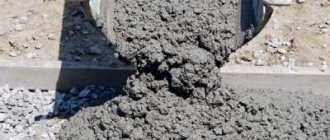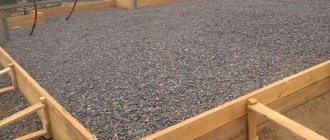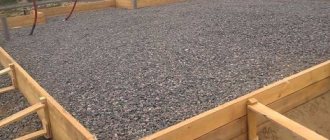Brick is a popular and in demand material in construction. It has excellent performance characteristics. Reliable material can withstand significant loads from floors, ceilings and roofs. Its advantages include low thermal conductivity, high strength to deformation and bending, long service life, and sound insulation. A brick building does not require a massive foundation. The thickness of the external brick walls affects the load-bearing capacity of the building. Next, we will consider the established standards that are relevant today.
Brick wall parameters
Optimal thickness of a brick wall. Standard indicators
The thickness of the walls of a house can vary over a wide range - 12 - 64 cm. The most common thickness is 2 bricks. This masonry is highly stable and reliable. The thickness of the brick wall according to GOST should provide the building with maximum strength.
The state standard regulates that when constructing residential buildings with up to 5 floors in a temperate climate zone, the minimum thickness of the supporting structure should not be less than 51 cm.
How to find out which wall is load-bearing in a panel house
Panel houses are distinguished by the fact that they have special design codes, which can be used to understand how they were built. There are special databases in which, knowing the code, you can find a house plan and the required apartment, where it will be indicated which wall is load-bearing in it.
You can also find such a wall by measuring the thickness of surfaces. Non-load-bearing walls in panel houses usually have eighty millimeter or meter walls. And the underlying surface of interest has a thickness of one hundred and forty to two hundred millimeters.
If you decided to check the thickness of the wall before removing the finishing coating, then it can affect the obtained indicators; they take about fifty millimeters.
You can find such a wall by measuring the thickness of the surfaces.
Nuances of choosing the type of masonry
When choosing the type of masonry, builders take into account the following factors:
- Load. First of all, it is necessary to take into account the number of floors of the building.
- Climate zone. It is important that the building is warm in winter.
- Aesthetic component. Thin masonry looks more elegant compared to thick masonry.
- Compliance. The structure must be safe to use.
For internal load-bearing walls, masonry with a thickness of 25 cm is used, which corresponds to one brick. For partitions that serve to divide rooms into zones, 12 cm is sufficient. The rigidity of such a structure is imparted by reinforcement with ordinary wire, which is placed in the seams.
Single brick masonry
When the temperature drops to -30 degrees in winter, keeping the house warm is a task that 64 cm masonry successfully copes with. However, it should be taken into account that the weight of the structure increases and a more massive foundation is needed.
When building a residential building in the southern region, a masonry scheme of 1.5 bricks can be used. If you need to build a barn or other utility room, then laying one brick is enough.
Safety precautions
When performing work on the construction of external and internal load-bearing walls and partitions, strict compliance with the requirements of labor safety measures set out in SNiP 12-04-2002 (section 9) and SNiP 12-03-2001 Labor safety in construction is necessary. Part 1. General requirements.
Lifting building materials and products to the floor, moving them to workplaces must be carried out using lifting means and packaging means to prevent them from falling and being damaged.
Workers receiving loads at masons' workplaces must be trained and have a slinger's certificate. A stable radiotelephone connection must be established between the workers and the tower crane operator.
Before installing carpentry, all window and door openings in the external walls being constructed must be fenced or closed with safety shields (grids).
Prohibited
when laying masonry, stand on it with your feet or lean on it.
The flooring used must be of stock production only. It is prohibited
to use pallets, boxes, containers, as well as other objects not intended for these purposes as scaffolding .
The gap between the wall (partition) being erected and the working floor should not exceed 50 mm. The flooring of working scaffolds must be regularly (at least 2 times per shift) cleared of debris. Protective canopies with a plan size of at least 2 x 2 m must be installed over the working entrances to the section. The suspended scaffolds used must be of an inventory type only and subject to periodic inspection.
In areas of masonry of external walls, external inventory protective canopies must be installed in the form of flooring on brackets. The brackets are hung on steel clamp hooks attached to the wall being built along the course of its laying. The first row of protective canopies is installed at around 3.300, and is maintained until the completion of the construction of the external walls. The second row of protective canopies is installed on the external walls and is rearranged along the course of the masonry every 6 m. It is allowed to use the second row of flooring made of mesh materials with a cell size of no more than 50 x 50 mm.
All construction waste generated during the work must be collected in a special container (garbage container) and, as it accumulates, removed from the floor by tower crane for removal off the construction site. Removing construction and household waste by throwing it down through window or door openings or from balcony slabs is prohibited.
Quality control of brickwork work
— acceptance of previously completed installation work preceding brickwork
— quality control of building materials and products used for masonry and mounted lintels
— control of production operations related to the production of stone works and laying of lintels over openings
— acceptance control of completed stone work with execution of inspection reports for hidden work.
Acceptance of previously completed work prior to the construction of external and internal load-bearing walls and partitions should be carried out in accordance with the requirements of Section 2, paragraphs 2.111...2.113 of SNiP 3.03.01-87 and working drawings of the project.
Control of production operations is carried out according to the scheme of operational quality control of stone work and work on the installation of lintels over window and door openings of walls and partitions.
Which material is best for construction?
The modern construction market offers bricks: double, single and one-and-a-half. The dimensions of a single brick are 250 x 12 x 65 mm. The one-and-a-half standard size is 250 x 120 x 88, and the double size is 250 x 120 x 138. If you choose the most effective material from an economic point of view, then it is more profitable to take the last two standard sizes. High-quality materials are used to construct the base.
Having calculated what the thickness of the brick wall should be, all that remains is to select the right material:
- Unlike ceramic solid bricks, hollow bricks are specially left with voids inside. These products are produced by ordinary workers and cladding.
- Porous ceramic blocks can provide excellent thermal insulation properties. This is an ideal option to save on the use of insulation.
- Refractory fireclay bricks perfectly withstand high temperatures. It is used to lay out fireplaces and stoves.
- White sand-lime brick is resistant to moisture and temperature fluctuations.
- Hyperpressed brick is highly durable. It does not absorb steam and does not allow moisture to pass through.
It is recommended to buy facing bricks in large quantities at once to avoid differences in color shade.
Types and sizes of bricks
Depending on the characteristics of the structure, bricks are divided into solid and hollow. A distinctive feature of the latter is the presence of special air pockets inside. When using hollow products, you can reduce the width of the brick wall and reduce the load on the foundation.
Hollow brick has higher heat-saving properties, since inside it there are voids with air, which is considered a first-class heat insulator.
Classification by materials of manufacture
Along with traditional ceramic, walls are often built from sand-lime brick. When producing this material, they do not resort to firing. The brick is made from quartz sand and lime in a ratio of approximately 9:1. A single block with strength characteristics acceptable for construction is obtained through a chemical reaction - lime slaking. It takes place in an autoclave, where bricks are steamed under pressure at temperatures exceeding 200 degrees.
Another type of brick is hyperpressed. In fact, it is only related to traditional brick by its shape and scope of application, while in terms of composition and manufacturing technology, it is more of an artificial stone. The main material (approximately 85% by volume) can be limestone, all kinds of quarry waste and industrial waste. Other components include cement for strength and iron oxide pigments for coloring.
The production of hyperpressed bricks takes place under a pressure of about 40 MPa in special molds, into which a moistened mixture of mineral base and cement is placed. High pressure ensures significant mutual friction of raw material particles, which are connected at the molecular level, which ultimately guarantees unsurpassed strength of the material.
Hyprepressed brick acts as an excellent waterproofer, as it does not allow moisture to pass through at all. It is used primarily as a facing material in cottages and private houses.
Classification by size
Depending on the size, the following types of bricks are distinguished (all values are in millimeters):
- single (250 (length) x 120 (width) x 65 (height));
- one-and-a-half (the same length and width, height – 88);
- double (same length and width, height – 138).
The greatest economic feasibility is the use of the last two types of products for the outer wall. From them it is possible to construct more massive structures using cement mortar in a smaller volume.
The thickness of the internal partition does not have to be too large, so a single or even half brick is suitable for its construction.
Improving thermal insulation properties
The thickness of a load-bearing brick wall is often increased through the use of insulation. Its use in internal construction is in demand, as it has many advantages. The thickness of the load-bearing wall can be increased slightly depending on the choice of thermal insulation materials. Insulation also needs to be carried out outside the structure. Consider the construction pie:
- The thickness of the outer part of the structure with masonry of 0.5 bricks is 12 cm.
- The insulation is selected taking into account the climatic region.
- The thickness of the internal part of the structure must be at least 25 cm. The building materials are blocks or bricks.
The thickness of the supporting structures, regardless of the choice of material, must be no less than that specified in GOST.
We demolish walls during redevelopment, what can be demolished and what cannot
Many people, especially those living in Khrushchev-era apartment buildings, try to remodel their small and uncomfortable apartments using redevelopment. But it’s one thing to do it in an individual building, and quite another to change a doorway or move a partition in a high-rise building, where almost every wall is load-bearing. All this ensures the safety of residents in combination with the entire technical design of the house.
What is redevelopment? According to the Housing Code, this concept includes all changes in the configuration of the apartment that require inclusion in the technical passport. This:
- changing the location of load-bearing walls and partitions,
- relocation of window and door openings,
- re-equipment of vestibules and dark storage rooms,
- arrangement of internal stairs,
- refurbishment of bathrooms,
- division of large rooms,
- expansion of living space due to household premises,
- glazing of a balcony or loggia,
- replacing gas stoves with electric ones,
- moving a bathroom, kitchen or toilet.
All these types of changes in the apartment relate to redevelopment and require approval from the relevant authorities.
What cannot be demolished: a load-bearing wall
Most often, redevelopment involves the demolition of interior partitions. But not everyone knows which walls can be touched and which ones cannot. Reckless demolition of structures leads to a change in the action of forces on the remaining surfaces and rooms located below.
In addition, ceilings left without support may not withstand the load and collapse at any time.
Since, in addition to separating different rooms, the wall elements serve as ceiling supports for all similar structural elements located above.
The main (load-bearing) walls in practice are located perpendicular to the floor beams. If it is made of concrete slabs, then their ends rest on the surface of the supporting structure. Usually these are walls between apartments and blocks, or external ones. As a rule, only partitions are equipped inside the apartment.
How to find out which wall is load-bearing?
Is it possible to determine the purpose of the wall yourself? Certainly. By its thickness or the material from which it is built. In panel-type houses, internal blocks have a thickness of up to 120 mm. Therefore, they can be considered partitions (their thickness ranges from 80-120 mm).
The load-bearing surface must have a thickness of at least 140 mm. Most often, in such houses, the external walls are made with a thickness of 200 mm. In brick houses, external, load-bearing structures have a thickness of 380 mm or more, inter-apartment structures - 250 mm, and partitions - 120 or 80 mm.
The material most often used for load-bearing walls in panel houses is wall or inter-apartment blocks made of reinforced concrete with various additives to lighten the structure and increase thermal protection. Internal partitions in 90% of panel houses are made of gypsum concrete panels. In brick buildings, the main material for all walls is red and sand-lime brick, which differ in size. Gypsum concrete panels can also be used as partitions.
Of course, no one is going to demolish the outer walls, but the partitions can be removed by obtaining the appropriate permission. To accurately determine which wall is load-bearing, it is best to use BTI data - a detailed floor plan. There, all main walls are marked with thicker lines, and partitions that do not have such functions are marked with thinner lines.
What is needed for demolition?
In any case, before starting work on demolishing a particular wall and moving it, you need to consult a qualified specialist. As well as a full calculation that takes into account the distribution of loads that must be transferred from old structures to newly erected ones.
In addition, you may have to change the power supply circuit. In addition, it must be borne in mind that uncoordinated demolition of the walls of the premises may prevent its sale or the preparation of donation documents, etc. But that’s not all.
Such actions are considered illegal and entail fines, summonses to court, and can even lead to confiscation of the apartment.
Therefore, approval of the redevelopment project is necessary in any case. What is needed for that?
- A plan developed by the BTI service specifically for this type of redevelopment.
- Drawing up a technical report for the demolition of the wall.
- Obtaining a positive conclusion from the housing inspection at the place of registration.
Display all materials with the tag:
- construction works
- organizational matters
Calculation of material consumption
After completing the construction plan, the surface area is calculated based on the dimensions of the walls:
4*3+3*3+4*3+3*3=42 m2
You need to calculate the area of one block. Based on the calculation that the masonry will be built in one brick, the parameter can be easily found by multiplying the width by the height:
0.12*0.065 = 0.0078 m2.
1 m3 of brick weighs approximately 1800 kg. Based on this, you can make a calculation of what the number of bricks should be for the construction of a particular object.
5385/1800≈3 m3
Let's summarize. According to GOST, the wall thickness must be no less than the specified standards. The indicator varies: it is influenced by the climate zone, as well as the type of building. If the construction project was developed by professional specialists, then you can calculate the consumption of the main building materials yourself using the numbers from the diagram. Correctly performed calculation allows you to reduce costs during the work process. You can buy the required number of blocks at once to avoid unnecessary material waste. On the other hand, the exact number of bricks will allow you not to purchase additional building materials after the start of construction work.
Requirements for building materials
Brick is the most popular material for building houses; there are hundreds of manufacturers producing products with distinctive characteristics. Before purchasing it, the developer will need to familiarize itself with its production parameters so that they comply with GOST requirements.
The most important of them:
- Strength characterizes the ability of a brick to withstand external natural factors without destroying the structure. This characteristic is marked “M”. For wall structures of residential buildings, bricks of M - 150 and M-200 are allowed, which corresponds to a compressive strength of 150 and 200 kg/cm2, respectively. The brand of brick is also characterized by bending strength, which for the above modifications is respectively 22 and 34 kg/cm2.
- Thermal resistance should be from 0.5 to 0.8 W/m*K and characterizes the ability of the wall to retain heat in the house.
- Moisture absorption is set at 6-14%, this is a high figure, but the porous structure of the brick cannot guarantee less, therefore, during the construction of walls, waterproofing will be required, which, as a rule, is performed in the process of thermal insulation of external walls.
- Frost resistance is set at F50 and must provide at least 50 freezing/thawing cycles of the walls.
- The vapor permeability of brick corresponds to 0.14-0.17 Mg/(m*h*Pa).
- The shrinkage of bricks is no higher than 0.1 mm/m; for this reason, cracks in brick buildings are quite rare.
- Sound insulation of walls of 1.5 bricks provides protection of 50 dB, which corresponds to SNiP.
- The fire resistance of a brick should provide resistance to direct flame exposure for more than 5 hours; in practice, this figure is higher and reaches 10 hours.
Scheme
Laying walls of 1.5 bricks can be done with single-row or multi-row ligation. The first is considered stronger and more durable and involves swapping the tie and spoon rows from the outer part of the wall being built, while observing the following basic rules:
- the rows at the top and bottom are laid with pokes from the outside;
- longitudinal seams in the following rows are shifted by 1/2 bricks, transverse seams by 1/4;
- the blocks of the upper row overlap the vertical seams of the lower one.
This laying method has a significant drawback, since it will require many incomplete bricks, which leads to increased labor intensity of construction work and increased mortar consumption.
Multi-row dressing is performed according to the following row scheme:
- the first is “spoon-poke”;
- the second is “poke-spoon”;
- from 3 to 6 - laying only with spoons with dressing of seams in 1/2 brick;
- from the 7th row the action is repeated from the first row.
Corners are considered the basis for the construction of walls of any object, therefore even the slightest mistakes made during their laying will lead to damage to geometric shapes, and, consequently, to a decrease in the load-bearing capacity of the structure and the duration of its operation.
When using the 1.5 brick technology, the construction of corners is carried out 4 rows ahead. This is required so that it is possible to install the order and expose the cord. In this case, it is possible to maintain horizontality as accurately as possible when laying rows.
The correct layout for laying one and a half bricks is in the video:
How many pieces will you need?
To calculate the volume of building material for a two-story house in a 10x10 m plan:
- The perimeter is determined by the outer walls: 10x 2+ 10 x2 = 40 m.
- At a height of 3.00 meters, the area of the wall structures is: 40 x 3.0 = 120 m2.
- The area of windows and doors is 11 m2.
- When laying 1.5 bricks, the wall thickness is 380 mm.
- According to the table, it is chosen that 1 m2 of walls with 1.5 bricks requires 189 bricks
- Brick consumption: (120-11)* 189 = 20601 pieces.
- Mortar consumption taking into account a 5mm thick mortar joint: 5.263 m3.
How to reduce the thickness of buildings and improve thermal insulation
People planning to build their own housing with their own hands may be interested in the answer to the question: “What thickness should the structures have in order to maximize the thermal performance of the building and its insulating properties?” As you know, constant noise has a bad effect on a person’s overall well-being. The problem of good sound insulation is most pressing for those who live near a train station, airport or factory.
Brick walls with an air cushion provide effective protection against noise. The technology is called well masonry. Between the walls of the house, 25 cm each, an empty space is left, which is filled with porous material:
- light concrete mixture;
- slag;
- organic insulation;
- expanded polystyrene;
- expanded clay.
well masonry with insulation
A cavity filled in this way makes it possible to reduce the overall weight of the structure and increase the level of thermal insulation.
To create an insurmountable barrier to cold from the street, you will need to make a ventilated façade. For this purpose, special heat-insulating panels, plasters and various facing materials are used.
Installation of a ventilated facade
The masonry of the 25 cm external wall is finished with facing bricks from the outside, and the structure must be insulated on the inside.
The following scheme is proposed:
- On the inside, the brick walls of the house are sheathed with insulation.
- The insulation layer is covered with a vapor barrier film.
- A metal mesh is laid on top and plastered. Alternatively, you can use drywall.
- Perform interior decorative finishing. Its task is to close all previous layers of the “pie”.
Insulating the wall from the inside
The result is cheap and cheerful. With the right approach, a practical owner will be able to reduce the initial cost of the property by 20%.
Building materials should not be used in areas of high seismic hazard. During a strong earthquake, the masonry is destroyed to the foundation.
Design Features
Not everyone knows the intricacies of construction technology. A completely legitimate question is: what is a monolithic brick building? This is a building constructed from solid concrete, with external cladding and internal partitions made using brick.
In most cases, in order to improve thermal insulation characteristics, the gap between bricks and concrete is filled with waterproofing material and insulation.
Using formwork, which is an auxiliary equipment, builders pour various structural elements of the building:
- capital walls;
- base;
- interfloor coverings.
When constructing monolithic houses, panel formwork is used, made of durable steel sheets, light aluminum, non-metallic materials, and wood.
By monolithic concrete we mean the technology of its production directly on the construction site, by pouring concrete into the formwork
The following types of formwork are used:
- Removable design.
It is dismantled after the reinforced concrete has hardened. The panels are moved to the next work area, where the frame is formed, reinforcement cages are installed, and concrete is poured. It is used in the construction of residential buildings and high-rise industrial buildings. - Stationary type.
After pouring, the panels remain as an integral structural element of the building. This type of formwork technology, in addition to the formation of a reinforced concrete monolith, performs a waterproofing function, additionally insulates the building, and insulates it from extraneous noise. It is better to carry out private construction of a building using such formwork.
Let us dwell in detail on the positive aspects of the technology for constructing monolithic buildings lined with brick on the outside.
What owners of suburban brick residential buildings need to know
Laying the walls of dacha buildings with two bricks is an excellent design solution for the Siberian winter, if combined with insulation of structures outside and inside. It is profitable to build such a construction project from an economic point of view.
When choosing which wall thickness is most suitable, we must not forget that a building material that has high strength also has great inertia. This means that it is best to build buildings from brick for permanent residence, where temperature changes during the day are insignificant. Owners of brick country houses should know that it will warm up slowly if in winter the owners do not live in it permanently, but only come from time to time.
Residential buildings made of brick will serve their owners for a long time. They are warm in the cold season and cool in the summer.
Our article would not be complete without a video. Watch a video about brick walls:
Builder tips
Experienced professionals can almost always give some useful tips for beginners, without which they would be guaranteed to make one of the common mistakes. For example, a fundamental point is the correct calculation of the foundation, taking into account the hydrogeology of the selected area. You should understand where the groundwater is located, how much there is, how much its quantity is affected by normal precipitation, and whether the soil under the future home is equally stable throughout the year. If this is not taken into account, then even a correctly calculated foundation, supposedly of sufficient strength, can “float”, especially if it is also made of brick and has limited bending strength. In such a situation, it will only contribute to the stretching of the walls above it and the bending of individual blocks, because cracks in the walls will appear too quickly and the building will not survive for long, posing a real threat to its inhabitants.
A separate point is the insulation of the external walls of the house or lining the main wall with facing materials. Many beginners do not take into account that it is necessary to leave a small gap between these two layers, because if there are temperature changes, condensation will still appear there, which can destroy the structure. If moisture gets inside, fungus can also penetrate there, which over time destroys the structure of building materials and increases the wear and tear of the house.
To avoid such phenomena, it is necessary to properly organize the ventilation of the space between the walls, for which special ventilation boxes are used. This device is made of very durable materials that can normally withstand any humidity and temperature changes without deformation. Thanks to them, thermoregulation inside the wall occurs naturally, and excess moisture gets out, so it does not accumulate inside and does not destroy the structure so much.
To learn how to properly make brickwork with your own hands, watch the following video.
Laying scheme
Any scheme can be implemented efficiently only on a solid foundation. It is recommended to install wooden formwork, removable type, which will form the wall structure.
Next, the order is installed - a specialized device made of slats having divisions and angles that determine the size of the horizontal rows. It also secures a mooring cord to determine the strict vertical/horizontal alignment of the masonry.
Throughout the entire process of wall construction, it is necessary to follow the sequence indicated by the masonry diagram:
- The lowest and highest rows are installed strictly perpendicular to the wall.
- The bond brick is laid first on the base, and the masonry is also finished with it, using only solid blocks.
- Coincidence of joints in adjacent rows is not allowed.
- To prevent the formation of cracks in the wall, a tie row with reinforced mesh is placed after 5 horizontal rows.
- The laying is carried out according to the single-row or multi-row principle.
It is well known that there are two main options for building a single-brick wall - “pressed” and “butted”. The first is more difficult to implement using thick masonry mortar, and the second is using relatively rare concrete mortar.
With the “press-in” method, vertical seams are formed by laying mortar from the end of the block, supporting it with a trowel. The “butt joint” method involves creating grooves in areas of vertical seams. This option requires plastering of the surface, which creates a stronger wall that does not require reinforcement.
For single-brick masonry, various dressing options are used:
- transverse seams, it prevents the blocks from moving along the wall;
- vertical seams;
- transverse seams will not allow the wall to separate vertically, while the structure has a more uniform load distribution.
Finishing
Finishing involves removing visible imperfections to give the wall the most attractive appearance. Typically, the following actions are performed:
- sharp protrusions and sagging are eliminated;
- the seam becomes more pronounced;
- grind off the protruding points using sandpaper;
- painting is done.
To give the decor the desired color, you need to paint the bricks. It is better to paint the surface before removing the markings. If the marking has already been removed, you will need to protect the seam with masking tape.
Before painting, the imitation will need to be primed again. The paint can be applied with a roller. To obtain a monotonous color, most often only 2 layers are required. After the paint has dried, a varnish coating is applied, which protects against adverse external influences and fading.
For better coloring, you can use a brush
The seams can also be painted to give them a more attractive look. It is necessary to use tape if different colors are used.
Marking
The easiest way to mark is to use thin masking tape. You will first need to draw the masonry with a marker. Tape will be glued along the finished lines. If you don’t want to waste time gluing tape, then it is recommended to purchase ready-made brick wall templates for interior decoration. They are sold in many hardware stores. The template is also worth considering if you plan to decorate a large room.
After the markings have been applied, you can proceed to applying putty. It is worth remembering that the final result will depend on the accuracy of the markings.
Defects that reduce the strength and stability of walls
Violations and deviations from project requirements, construction norms and rules,
which builders allow (in the absence of proper control on the part of the developer),
reducing the strength and stability of the walls:
- wall materials (bricks, blocks, mortar) with reduced strength compared to the requirements of the project are used.
- metal anchoring of the floor (slabs, beams) to the walls is not performed according to the design;
- deviations of the masonry from the vertical, displacement of the wall axis exceed the established technological standards;
- deviations in the straightness of the masonry surface exceed established technological standards;
- The masonry joints are not filled completely enough with mortar. The thickness of the seams exceeds the established standards.
- excessive amounts of brick halves and chipped blocks are used in the masonry;
- insufficient connection of the masonry of internal walls with external ones;
- omissions of mesh reinforcement of masonry;
In all of the above cases of changes in the dimensions or materials of walls and ceilings, the developer must contact professional designers to make changes to the design documentation. Changes to the project must be certified by their signature.
Your foreman’s “let’s make it simpler” suggestions must be agreed upon with a professional designer. Control the quality of construction work done by contractors. When performing work on your own, avoid the above construction defects.
The norms of the rules for the production and acceptance of work (SNiP 3.03.01-87) allow: deviations of the walls along the displacement of the axes (10 mm
), by deviation of one floor from the vertical (10
mm
), by displacement of the supports of floor slabs in plan (6...8
mm
), etc.
The thinner the walls, the more they are loaded, the less safety margin they have.
The load on the wall multiplied by the “mistakes” of designers and builders may turn out to be excessive (pictured).
The processes of wall destruction do not always appear immediately, but sometimes years after the completion of construction.
The principles of designing a house with minimal wall thickness are clearly visible in the following photos. In house designs with thin walls, elements made of monolithic reinforced concrete are widely used.
The simple architectural form of the house allows the use of commonly available materials for construction and helps optimize construction costs.
The house has 114 m2
usable area and is designed for a family of 4-5 people. In the attic there are three bedrooms and a bathroom.
On the ground floor along the southern facade with large windows there is a spacious living room combined with a dining room and kitchen. In the other part there is an office, a bathroom and a technical room.
Silicate blocks were used to lay the outer walls of the house. Wall thickness 180 mm.
Thin walls increase the usable area of the house.
The house is designed in such a way that there are no internal load-bearing walls.
Inside the house there is a load-bearing beam, which is supported by two columns inside and two columns built into the masonry of the external walls. The beam itself and the columns are made of monolithic reinforced concrete. This solution allows for a free layout of the premises on the floor.
To increase the resistance of the walls to loads, there is a monolithic reinforced concrete belt at the floor level of the first floor. The section of the wall with wide, high windows and narrow partitions on the southern facade is also made of monolithic reinforced concrete.
The roof of the house rests on a monolithic reinforced concrete belt on top of the attic walls. Reinforced concrete columns are installed in the attic walls of the attic, on which the roof mauerlat rests. The need for columns in the outer walls is due to the fact that these walls do not have cross connections inside the attic. The absence of transverse walls allows for a free layout of the attic rooms.
Formwork for installing a monolithic column in the outer wall of a house. The column serves as a support for the load-bearing beam inside the house.
Installation of formwork for monolithic columns along the edges of wide window openings.
In the background you can see the formwork for the columns inside the house. The two columns inside are located on the same axis with the columns built into the outer walls.
The floors in the house are prefabricated monolithic, often ribbed, on the same level as the monolithic reinforced concrete wall belt.
The monolithic floor, made integral with the monolithic belt of walls, together with the walls, creates a single and durable spatial structure - the skeleton of the house.
The attic walls of the attic are 1.3 m high.
, on which the roof mauerlat rests, are reinforced with monolithic columns built into the masonry.
Formwork for the construction of monolithic columns and attic wall belts. The southern facade of the house with openings for tall large windows. Inside, a monolithic beam is visible, which rests on two columns inside and two columns built into the masonry of the outer walls.
The rafters of each roof slope at the top rest on a truss, the ends of which, in turn, lie on the opposite gable walls of the attic. This solution made it possible to abandon the intermediate posts of the ridge beam. As a result, the space inside the attic is free for planning. The angle of inclination of the roof slopes is 42 degrees.
House foundation
— monolithic reinforced concrete slab with a thickness of 250
mm.
The foundation slab lies on a layer of insulation. Non-removable formwork made of insulation. Insulation slabs are laid along the perimeter of the foundation, under the blind area. This solution prevents freezing of the soil under the foundation.
Wall thickness 200-250 mm
It is certainly advisable to choose brick or blocks for a one-story house or for the top floor of a multi-story house.
The house has two or three floors with a wall thickness of 200-250 mm.
build if you have a ready-made project at your disposal, tied to the ground conditions of the construction site, qualified builders, and independent technical supervision of construction.
In other conditions, for the lower floors of two- or three-story houses, walls with a thickness of at least 350 mm
.
To ensure the strength and stability of a private house with a minimum wall thickness, the installation of a monolithic reinforced concrete belt has become standard. The belt is placed on top of the external and internal load-bearing walls on each floor of the house. Beams and floor slabs, roof slabs must be connected (anchored) with metal ties to a reinforced concrete belt on the walls of the house.
How to make load-bearing walls only 190 mm thick.
,
Next article:
Previous article:
Modern houses must meet fairly high requirements for thermal protection. External walls made of brick have excellent load-bearing properties. However, if you calculate what thickness of brick walls should be made in accordance with the requirements, the result is unrealistic - about 3 m.
The problem is that materials that have excellent thermal resistance characteristics have low load-bearing capacity, and vice versa. At the moment there is no material that would meet all the necessary requirements in all areas. So, what is the optimal thickness of a brick wall?
Check out other rooms where white brick would work
White brick is an excellent solution for a hallway. It will look great in a long and narrow corridor. It is worth using it in a place where there is a cabinet with a mirrored facade opposite. You can also use cladding on the wall with the front door - it goes well with the black modern canvas.
A white brick wall adds variety to the decor of a teenager's room. It will look especially good in a room equipped with a black metal bed and other furniture with a simple design. Backlit brick will look great in a teenager's room. A wall of statement material can be the backdrop for graphics made by a teenager or purchased.
Are you wondering if white brick on the wall can brighten up your bathroom? This is a room with a high level of humidity. However, the use of impregnation will allow you to decorate the room with a fashionable finish. If you are still afraid of brick in the bathroom, choose porcelain tiles that imitate it, the smooth surface of which is easy to keep clean and resistant to moisture.
In which rooms is brick suitable?
- In addition to the living room, bedroom and kitchen, a great place to use brick is the hallway,
- White brick finishing will also work well in a teenager’s room, especially if there is furniture with a simple design,
- White brick can decorate a bathroom if you use impregnation,
- You can also choose a replacement in the form of porcelain stoneware that imitates brick.
Besides the living room, bedroom and kitchen, the hallway is a great place to use brick.
Joining seams
To obtain sufficient compaction of the mortar in the seams, as well as to give the brickwork a clear pattern on the outside, jointing is used. In this case, brick laying is carried out with cutting the mortar. When stitching, the seams are given the following shapes:
- triangular,
- concave,
- convex,
- rectangular,
- rounded.
For example, to obtain convex seams, concave joints are used.
To obtain better quality seams and reduce labor costs, the seams of the brickwork are unstitched until the mortar sets, following the following sequence:
- use a brush or rag to wipe the surface of the brickwork from mortar splashes adhering to it;
- embroider vertical seams (3-4 spoons or 6-8 stitches);
- unstitch the horizontal seams.
If in the future you plan to plaster the walls, then the bricklaying must be done empty, i.e. Do not bring the solution 10-15 mm to the wall surface. This method will allow the plaster to firmly adhere to the wall surface. © www.gvozdem.ru
| Undercut | Vpushoshovku |
| Convex seam | Concave seam |
| Single cut seam | Double cut seam |











